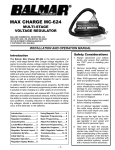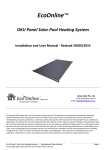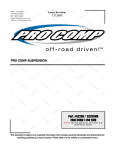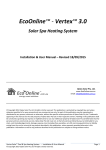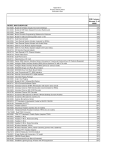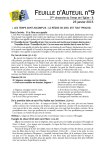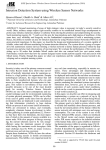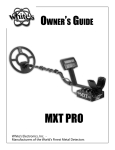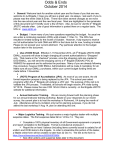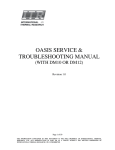Download Pura UV1 SERIES Specifications
Transcript
DC Genset/Watermaker Operations Manual 19009 61st Ave. NE #4,Arlington, WA 98223 Phone: (360) 435-6100, Fax: (360) 435-3210 E-Mail: [email protected], Web: www.balmar.net TABLE OF CONTENTS Setting Up Your Genset Unpacking Your Genset .................................................... 1 Preparation For Installation Space & Ventilation Requirements ................................ 2 Ventilation ............................................................................2 Exhausting............................................................................2 Fuel System ........................................................................2 Maintenance ........................................................................2 Installation Procedures Seawater & Freshwater Supply ...................................... 3 Exhaust System ..................................................................3 Starting System ..................................................................4 Cooling System....................................................................4 Fuel System ........................................................................4 System Alternator ..............................................................4 Voltage Regulator ..............................................................4 Alternator Direct Coupling Device ................................5-6 Key Panel ............................................................................7 Parts Required For Installation Mounting Genset................................................................ 7 Seawater Supply ................................................................ 7 Exhaust System.................................................................. 7 Starting System.................................................................. 7 Troubleshooting ........................................................................ 8 Warranty ...................................................................................... 8 Aqua Pac Voyager Operations Introduction ........................................................................ 9 Central Processing Module ............................................ 10 Pre-Filtration Module ...................................................... 10 Reverse Osmosis Module .............................................. 10 Pressure Regulator ........................................................ 11 Control Panel.................................................................... 11 Feedwater Pump ............................................................ 11 Emulsion Removal Module ............................................ 11 Plankton Filter Assembly .............................................. 11 UV/Charcoal Sterilizer .................................................... 11 Supplemental Filters ...................................................... 11 Freshwater Flush Assembly .......................................... 11 Watermaker Specifications .......................................... 12 Replacement Parts ........................................................ 12 Desalinator Operation Initial Watermaker Startup............................................ 12 Routine Startup .............................................................. 13 Routine Watermaker Shutdown .................................. 14 Prolonged Watermaker Shutdown .............................. 14 Temperature Effects on Performance.......................... 14 Freshwater Output Correction ...................................... 14 Properties Of RO Water.................................................. 15 Watermaker Installation Central Processor Module Mounting............................ 15 Product Water Outlet Connection ................................ 16 Waste Product Water Outlet Connection .................... 16 Input 12VDC Power Connection.................................... 16 Connecting Electrical Control Cable ............................ 16 Watermaker PRe-Filtration Module.............................. 16 Water Connections .......................................................... 17 Reverse Osmosis Module Assembly/Installation ...... 18 Pura UV Disinfection/Filtration System ...................... 19 Prior To Running DC Genset Electrical Connections .................................................... 20 High-Output Alternator Cables ...................................... 20 Cooling and Lubrication Systems ................................ 21 Fuel System ...................................................................... 21 System Control Panel .................................................... 21 Toggle Speed Control ...................................................... 21 Regulator Programming ................................................ 21 Starting Engine ................................................................ 21 Automatic Alarm Shutdown .......................................... 22 Activation of Charging System ...................................... 22 To Terminate Operation.................................................. 23 APV Checklist Activation of APV............................................................ 23 High Pressure Test .......................................................... 24 Manual Override Mode .................................................. 24 Filter Pack ........................................................................ 25 Final Thoughts ................................................................ 25 CAUTION! Please read ALL of the specific information included in this manual. Failure to do so could result in poor genset performance, mechanical and/or electrical damage, and serious injury to the operater and/or installer. Improper installation and/or operation may also nullify the manufacturer's warranty (see the "Warranty" page in this manual). SETTING UP YOUR DC GENSET Unpacking Your Genset Your genset was carefully packaged and inspected prior to shipping. Before uncrating the genset, inspect the shipping container carefully for any signs of damage. If major damage to the exterior of the shipping container is noted, notify the driver of the delivery vehicle immediately. Arrangements for inspection by a claims representative of the shipper should be arranged with the driver or with a shipping company customer services representative. If a camera is available, it may be helpful to document any damage with photographs. Once inspection of the shipping crate’s exterior is complete, the crate may be opened by unscrewing and removing the top panel. Inspect for any shipping damage and document. Your DC Genset package will contain the following: APC-750 APC-850 PC-750 PC-850 1. Engine 2. Control Panel 3. Expansion Tank Mounting Kit 4. Owner’s Manual 1. 2. 3. 4. 5. Engine Control Panel Expansion Tank APV Control Panel Pre-Filter Pack 6. 7. 8. 9. 10. 11. Pre-Filter Mounting Kit Water Puppy Kitz Valve Hayward Valve RO Membranes RO Membranes Order Form 12. RO Pressure Vessels 13. RO Membrane Mounting Kit 14. RO High-Pressure Fittings 15. RO Low Pressure Fittings 16. Bio Scrub Hose Kit 17. Cat Pump Oil 18. Owner’s Manual Once the contents of the shipping container have been inventoried and inspected for shipping damage, the four side panels may be removed by unscrewing the retaining screws. The genset can be removed from its supporting panel by removing the lag screws fastened at the four mounting feet. CAUTION: The genset weighs approximately 190 lbs. alone and in excess of 225 lbs. with the watermaker Cat Pump installed. DO NOT attempt to move the genset without adequate assistance. Failure to follow this guideline could result in damage and/or injury. If possible, the genset should be transported to its installation location with the assistance of a heavy duty hoist. The installation location must be capable of supporting a weight load well in excess of the genset and watermaker pump. Notes: -1- PREPARATION FOR INSTALLATION Space and Ventilation Requirements Several issues should be addressed when determining the optimal installation location for your DC genset: Ventilation, Cooling, Fuel Supply, Exhausting, Ease of Maintenance and Repair, Protection from the Elements. Ventilation: Both the genset’s diesel engine and high-output alternator require substantial airflow to ensure adequate cooling. The installation site should be free of any potential obstructions that could inhibit airflow. If airflow at the installation site is compromised, it may be necessary to introduce additional airflow with the addition of a fan or blower. Should you want the fan or blower to operate only when the genset is in operation, power may be pulled from the genset’s oil pressure switch or from the positive side of the genset’s ignition switch. Fuel System: Fuel input fittings at the engine are 1/4" in and 1/4" out. Preferred installations include a primary fuel filter with water separator (Racor type) before the engine. An electric or manual fuel pump and inline filter is installed on the genset. Adequate room for fuel filters and fuel pump must be provided. Exhausting: The DC genset is designed to be matched with a 13/4” exhaust. The installation site should provide ample space for the inclusion of the exhaust system. Each system will vary, based on ducting material, muffler type and thru-hull. Exhaust can be directed toward the front or rear of the genset. Maintenance: The DC Genset is designed to provide access to most commonly required service points on the same side of the genset. Care should be taken when locating the installation point to ensure that the access friendly side of the genset be located within easy reach of the operator. CALIFORNIA Proposition 65 Warning Diesel engine exhaust and some of its constituents are known to the State of California to cause cancer, birth defects, and other reproductive harm. -2- INSTALLATION PROCEDURES Seawater and Freshwater Supply Seawater supply hose must be a minimum of 5/8" ID and must not be obstructed by undersized sea water strainers, fittings, or sea cock valves. We recommend seawater hose and fittings be a minimum of 3/4". The larger the sea strainer, the better. Do not share the seawater inlet with the main engine through-hull unless a sea chest is available. If your system is fitted with a watermaker, ensure that the seawater intake is located forward of the head discharge or any other discharge that could foul your watermaker’s supply source. If the unit is installed below the waterline, a vented loop is required. The seawater supply line feeding raw cooling water into the system must be routed to prevent siphoning of raw water through this line into the exhaust system, filling the muffler and engine cylinders. This line should be routed at least 12 inches above the waterline and an anti-siphon break installed the top of its loop. This loop should be high enough above the waterline to ensure that it remains dry even while heeling. A small freshwater supply tank (expansion tank), bracket, and 10' of 3/8" clear hose are supplied with the unit and should be mounted level with the genset’s heat exchanger. Exhaust System Engine exhaust elbow is 13/4”. Exhaust line installations will vary considerably and each must be designed for the particular installation. The prime requirement is to provide an outlet line with a minimum of restrictions, situated in a manner that ensures seawater, rainwater and condensation cannot get back into the cylinders of the engine. Most exhaust systems today use a water lift muffler such as the Vernay or Vetus type. -3- Starting System The DC genset is equipped with its own dedicated charging system to support an independent starting battery. Should you choose to utilize a dedicated battery, or start the genset with the ship’s battery, ensure that battery cables are properly sized to support the genset’s starting load. The battery (+) lead will connect to the positive post of the small alternator attached to the genset’s engine. A jumper wire is already connected to the starter solenoid. The negative battery lead attaches to the lower starter mounting post. Fuel System Fuel is supplied to the genset via the main diesel tanks or a dedicated genset fuel tank. High quality 1/4” fuel line should be used to supply diesel to the genset. Fuel pre-filters and fuel pumps, as described on the preceeding page, should be used as needed. A 1/4” fuel return line is also required. Coolant System The genset is equipped with an onboard heat exchanger unit with an off-engine coolant recovery tank. The genset’s coolant system should be topped off after installation with a 50/50 mixture of water and coolant. The coolant recovery tank must be installed within 21" of the cap/manifold. This assures the cooling system will retain all fluids during normal operation. System Alternator The DC genset is equipped with a Balmar high output alternator and the Max Charge voltage regulator. An alternator temperature sender is installed on the alternator to protect it against over-heating. This alternator is a single output alternator. If your alternator model has a jumper strap supplied between the terminals, it must be left in place. The positive cable will connect to one of the ouput posts. The negative cable should be connected to one of the two bolt holes near the rear bearing at the center of the alternator. These cables should be properly sized and supported to avoid undue strain on the altnerator and fitting. For detailed information, see ‘Alternator and Regulator Owner’s Manuals’ in the manual. Brushless 98-Series Alternator Voltage Regulator The Max Charge voltage regulator is included with the DC genset in its own shipping container within the crate. The regulator includes a 54" wiring harness, which allows installation on stringer or bulkhead near the genset. The brown (switched) wire in the regulator wiring harness should be connected to the (brown) switched source wire located near the speed control box and oil pressure switch. Switched source wire is identified with a marking tag. -4- Alternator Direct Coupling Device (Lovejoy #LF4 Coupler) The alternator is coupled to the genset engine via a flexible torsional coupling (Lovejoy #LF4). The coupling is installed prior to shipping and should require no user adjustment thereafter. Should you need to remove and replace the alternator and coupling, re-installation will require strict adherence to the following procedural guidelines: 1. Inspect all contact surfaces on the Lovejoy coupler (bare metal surfaces on the rubber coupling unit) for oil, dirt or other contaminants. Clean those surfaces thoroughly with a medium grit sandpaper and wipe clean. Clean flex ring adapter (metal ring attached to the engine flywheel) and pulley flange as well. 2. The Lovejoy is connected to the flex ring adapter under compression. When installing the Lovejoy coupling you will find that the threaded holes on the flex ring will not necessarily align with the Lovejoy without some manipulation of the coupling. 3. Attach the Lovejoy to the flex ring with a single 25mm capscrew. Turn the capscrew a couple of rotations -- just enough to ensure proper threading. 4. One-by-one, insert the Shows correct and incorrect axial coupling alignment. remaining capscrews and turn just enough to ensure proper threading. It may be necessary to compress the Lovejoy to align with the threaded holes on the flex ring. Once all of the capscrews have been started, each can be tightened to 20 ft.lb. Inspect coupling attachment for proper alignment, as shown in illustration above. Alternator Attachment 1. Ensure that the aligning capscrew is attached to the center bore on the tensioning crown of the alternator. Align alternator so the flange in the pulley assembly fits evenly inside the center hole in the Lovejoy coupling and the head of the aligning capscrew fits in the indexing hole in the alternator bracket. 2. Once aligned, insert the 3/8” hex bolts in the two remaining holes in the alternator tensioning crown (on either side of the indexing screw). These bolts will thread into the alternator bracket. There may be some play in the bore containing the hex bolts. Don’t be concerned. The head of the indexing capscrew will ensure proper alignment. 3. Insert the 1/2” hex bolt at the remaining alternator foot and thread into the alternator bracket. Torque the alternator retaining bolts to 38 ft.lb. 4 Insert the Nordlock (locking washers) into the radial cavities of the Lovejoy coupling. (Inserting the washer at an angle to the coupling makes it easier to insert the washers). 5. Align the screw holes of the Lovejoy with the threaded holes in the pulley by turning the alternator fan. -5- 5. Once aligned, insert the 30mm Capscrews into the three radial cavities in the Lovejoy. Tighten each capscrew just far enough to ensure proper threading until all screws are properly aligned and threads are started. 6. When all three capscrews are in place, Tighten to 20 ft.lb. It may be necessary, once all capscrews are in place, to turn the crank pulley on the engine to access all of the capscrews for torqueing. 7. Inspect the Lovejoy for proper alignment as illustrated at right. Loosen capscrews and re-tighten, if necessary, to ensure that the Lovejoy is free from distortion. Shows correct and incorrect radial coupling alignment. 8. Re-check torque. 9. Replace Cat Pump platform. 10. Re-connect wiring connections at alternator as described in the alternator manual included in the genset instructions. Notes: -6- Key Panel Electrical Connections for 12VDC motor functions are made at the molded plugs at the engine. One 20' extension cable is supplied with each system. There is a 25-amp fuse at the engine for panel and wire protection. The engine is supplied with oil pressure and temperature switces, and will shut down the engine in the advent of a malfunction. A red LED on key panel would indicate this. Key Panel includes: 1. Key Switch 2. Hour Meter 3. Toggle-Adjustable Speed Control for manual control of engine throttle 4. Toggle switch to turn ON-OFF system alternator 5. Digital voltage meter indicating system voltage - gray wire at ESC box should be connected directly to positive post at battery bank Wire should be fused near battery at three (3) amps.. 6. Mini toggle switch for ON-OFF system voltage meter 7. Pre-Heat, Run, and Alarm LEDs. PARTS REQUIRED FOR INSTALLATION Following is a general list of parts needed for installation. This is just a general list, as all boats are different and installation is unique to each one. Mounting Genset 1. (8) 5\16 Hex Bolts or Lag Bolts, w/nuts and washers as needed. Primary Fuel Filter and Water Separator w/ fittings 2. 1/4" Fuel Hose w/clamps (fuel supply) 3. 1/4" Fuel Hose w/clamps (fuel return) Fittings as needed to install hoses to boats fuel system Seawater Supply 1. Seawater Through-Hull fitting (3/4" or larger) 2. Seawater Intake Valve (ABYC approved) 3. Sea Strainer (minimum ¾") 4. Vented Loop fitting, optional (not necessary if mounting above water line). 5. Fittings as needed to make up intake valve, sea strainer and through-hull 6. 5\8" or 3\4" Intake Hose w/clamps Exhaust System 1. Exhaust Through-Hull fitting (1¾") 2. Water Lift Muffler (1¾") 3. 13\4" Marine Exhaust Hose w/clamps Starting System 1. Start Battery w/lugs 2. Start Battery Cables (minimum #6 AWG) w/terminals -7- PARTS REQUIRED FOR INSTALLATION (Continued) Battery Box Alternator System System Battery Cables (minimum #1\0 AWG - determined by length of run & percentage of line loss). TROUBLESHOOTING Balmar equipment manuals contain a user friendly troubleshooting section. This information is also available at our web site: www.balmar.net. Personal assistance in troubleshooting equipment is available through our Technical Support Department via E-mail ([email protected]) or phone (360435-6100, ext. 3). Our hours of operation are Monday - Thursday, 7:30 am - 5:30 pm PST. We are closed Friday - Sunday. There are endless possibilities that can cause a system to not operate properly, other than equipment defect. It is the responsibility of the owner to either troubleshoot the system or hire a qualified professional to do so. Non-Warranty Repair: If failure is found to not be covered under the terms of this warranty, customer will be presented with price to repair / replace. If repair / replacement is declined, equipment will be returned to customer as stated under #4, Return to Customer, or will be disposed of upon request. Loaner Equipment: Balmar does not provide equipment for loan to be used while failed equipment is undergoing analysis. If replacement equipment is required prior to warranty analysis, new equipment can be purchased. Used equipment may be offered for sale, subject to availability. LIMITED PRODUCT WARRANTY BALMAR warrants to the original consumer/purchaser the product is free from any defects in material or workmanship for a period of one year from the date of purchase. This warranty DOES NOT apply to defects or physical damage resulting from abuse, neglect, accident, improper installation, wiring, or repair, alteration, modification, or unreasonable use of the products resulting in breakdown, cracked or broken cases, parts damaged by fire, water, freezing, collision, theft, explosion, rust, corrosion, overheating or items damaged in shipment in route for repair. BALMAR assumes no responsibility for consequential damage or loss or expense arising from these products or any labor required for service or repair. Alternators are not covered when used with manual regulation devices. Following are requirements for determining warranty coverage: 1. Proof of Purchase: All Balmar equipment is production dated. This date is not adequate for warranty consideration, as new product can age significantly prior to end user purchase, installation, and placement in service. Proof of purchase is required for accurate calendar consideration. 2. Analysis of Failure: All equipment will be factory analyzed to determine warranty status prior to replacement or repair. Contact Balmar for return authorization (RA) number. Balmar can not be held responsible for any product sent without proper identification, return address, and RA number clearly marked on the package. Ship equipment prepaid to the location specified by Balmar. This warranty is not extended to costs of troubleshooting, including time, labor, or communication costs incurred either with Balmar or other marine specialists. 3. Determination of Warranty: If the equipment is found, upon analysis, to have failed under the terms of this warranty, it will be repaired or replaced. Balmar reserves the right to determine whether to repair or replace components. Allow 30 days A.R.E. (after receipt of equipment - expedited service is available upon request whenever possible). This warranty is in lieu of all implied or verbal warranties as to the merchant ability or fitness for a particular application. No person is authorized to repair, modify or assume additional obligations for warranty without the written authorization of a Balmar corporate officer. 4. Return to Customer: Once analyzed, equipment will be returned by surface freight to continental US destinations. International and offshore 'ship to' addresses, as well as 'rush' and expedited shipment requests, will require credit card for payment of freight charges. THE ABOVE LIMITATIONS MAY NOT APPLY TO YOU. SOME STATES DO NOT ALLOW LIMITATIONS ON HOW LONG AN IMPLIED WARRANTY LASTS. NO PERSON, AGENT, DEALER IS AUTHORIZED TO GIVE ANY WARRANTY OR REPRESENTATION ON BEHALF OF BALMAR UNLESS MADE IN WRITING BY AN OFFICER OF BALMAR. -8- Aqua Pac Voyager Operations Manual Pre-Filtration Module Control Panel & CPM Feedwater Pump RO Membranes Introduction The Aqua Pac Voyager is a revolutionary concept in providing fresh water from seawater for pleasure boats and for remote residences and encampments. The integrated desalinator is nominally rated at either 20 or 40 gallons per hour. The APV system is modular in design, combining required components, whether installed on a Balmar PC-750 or PC-850 DC Genset or used on its own. Aqua-Pac desalinator operates on the principle of reverse osmosis. The ions (salt) in seawater tend to form into clusters, which are many times larger than the individual pure water molecules. Under pressure, the pure water molecules are forced through a semipermeable membrane leaving the ion clusters behind. Although a simplification, this is basically how reverse osmosis works. In actual practice, the feed-water is drawn from the source through a coarse strainer, through three stages of filtration, and delivered to the inlet of a three cylinder reciprocating pump which is belt or direct-driven by the engine. This "high-pressure pump" forces the feed-water through the membrane, through a variable restrictor or "RO Pressure Regulator", and out to discharge. The RO pressure regulator creates the back pressure applied to the feed-water in the high-pressure vessel. While ionized feed-water, under pressure, is being forced over the membrane, pure water is permeated out of the membrane and is called "product water". The product water passes through a flow meter, which indicates the amount being produced, in gallons per hour. -9- From the flow meter, the product water enters a chamber called the "salinity cell" where two probes measure the electrical resistance of the product water. The residual ion content of the product water is inversely proportional to its electrical resistance, totally de-ionized having infinite resistance. Typical resistance of the product water will be in the neighborhood of 1500 ohms. The purity of the product water may also be expressed in mhos where the value would be the reciprocal of that in ohms. Additionally, the purity may be expressed as parts per million of total dissolved solids. The PPM value (at levels found in product water) is roughly half of the value in micro-mhos. If the salinity cell and associated circuitry determines that the product water is of acceptable quality, an electric "diversion" valve is opened and the product water is allowed to flow into whatever storage facilities are provided. Should the vacuum at the inlet of the high pressure pump become abnormally great due to clogged pre-filters or some other cause, an automatic circuit will stop the system and activate a "HIGH INLET VACUUM" light. RO pressure is indicated on the RO pressure gauge. Pressure in excess of 1000 PSI will trigger the pressure relief valve. Central Processing Module (CPM) The Central Processing Module is equipped with the system control switch, start button and all annunciator lamps. As will as the product water flow meter, salinity probe (MPU) in which water quality is measured, and the electric diversion valve (Burkheart valve) which directs potable product water into the storage tanks. The front of the CPM forms the system's main control panel. Pre-Filtration Module The Pre-Filtration Module is a three-stage filter system that removes suspended particulate matter from the incoming feed-water. Efficient pre-filtration contributes greatly to prolonging RO membrane life. The first stage consists SS strainer screen (Plankton filter) housed in a clear plastic bowl. The second stage is a 577 square inch, pleated-paper 50micron filter. The third stage is a 5-micron filtration cartridge. The SS strainer screen (Stage 1) can be cleaned and reused over again. The 50 and 5micron cartridges should be replaced as needed. You may want to save the best of the used, 5-micron filters for the cleaning process. A relay module mounted on the pre-filter assembly operates the electric clutch at the feedwater (Cat) pump and the pre feed pump (water puppy). The primary system fuse and over-ride switch used when performing the cleaning and preserving tasks, as well as terminal strips for convenient wiring are also mounted on this relay module. Reverse Osmosis Module (ROM) The Reverse Osmosis Module is where de-ionization takes place. Feed-water (seawater) under pressure flows out the high-pressure pump module and through the ROM highpressure vessel past the reverse osmosis membrane inside the pressure vessel. Pure water molecules permeate through the membrane fabric where they are collected and manifold to a tube in the center of the membrane. This "product water" then flows back into the Central Processing Module for further processing. Meanwhile, the feed-water that did not permeate through the membrane flows to the Pressure Regulator Module and is subsequently discharged as waste overboard. - 10 - Pressure Regulator The Pressure Regulator consists of a manual pressure regulator and a pressure gauge mounted on the control panel. The regulator maintains the proper back pressure on the membrane. Control Panel The Control Panel permits operation and monitoring of the system from a convenient location such as in the living quarter of a boat. Feedwater Pump The Pre-feed pump consists of a separate relay controlled pump that forces feed-water through the pre-filters. Installation of a feed-water pump will decrease pre-filter maintenance, system noise and vibration and RO pressure pump wear. If either the engine or the Pre-Filtration Module must be mounted more than two feet above the feed-water source level, a Feed-water Pump Module will be required as well as a check valve. A Feedwater Pump Module is recommended for all installations. Emulsion Removal Module (ERM) Optional This unit removes oil or silt from the feed-water, to further protect the RO membrane. This element should be replaced as soon as oil is detected or every year during normal servicing. Plankton Filter Assembly Optional This is a 50-micron SS element that works more efficiently than the sea strainer and never needs to be replaced -- just cleaned on a normal basis. This will not replace a sea strainer. Ultraviolet/Charcoal Sterilizer Optional Although the RO process is very effective at removing bacteria and other pathogens from the feed water, a UV/Charcoal Sterilizer can be added that will function as a second line of defense against any micro-organisms that may have penetrated the RO membrane. The UV Sterilizer is recommended anytime the desalinator is going to be used in brackish or sewage contaminated waters. The charcoal element removes foul odors and tastes in the product water. The charcoal filter is rated at .5 micron and should be replaced every year. It is a special style charcoal filter, call Balmar for replacement. The UV bulb should be replaced every 2000 hrs. or every two years. After recommended replacement time, the spectrum of the light will shift and cause insufficient radiation of the bacteria and viruses. Supplemental Filters A 5 micron filter is standard with the Aqua-Pac. 5 and10 micron filters are available in the standard size. Larger surface area filters are also available in various micron sizes. Media filters are available for land based or commercial applications. Freshwater Flush Assembly Optional This is a charcoal filter and three-way valve assembly designed to be installed onto the fresh water system for flushing the salt water out of the desalinator. Not intended for long shut down periods. Up to one month before re-flushing is required. - 11 - Watermaker Specifications Feed-w water pH Range: 3-1 11 Feed-w water Temperature Range: 40° to 100°F (4.4°C to 37.8°C) Membrane Salt Rejection: 98.6 % or greater Maximum Operating Pressure: 800 PSI Cpm Switched Accessory Terminal Output: 6 Amps @ 12 VDC High Pressure Pump Crankcase Lubricant: Balmar P/N 334-0 010 High Pressure Pump Crankcase Capacity: 12 oz *All performance specifications are with feed-water salinity of 35,000 PPM, feed-water pH of 8, feed-water temperature of 77°F (25°C), and operating pressure of 800 PSI. Product water output will decrease with lower feedwater temperatures. Rated output at a given temperature is +/- 15%. Replacement Parts Genuine Balmar replacement parts as well as modules and accessories are available from authorized Balmar dealers. As a convenience to Balmar product users, replacement parts are also available directly from Balmar Products. WARNING: Use of other than genuine Balmar replacement parts may impair the performance and/or inherent safety of the system and may also void the warranty. Replacement parts obtained from dealers are not necessarily genuine. Desalinator Operation Initial Watermaker Startup NOTE: If there is a chance that the ROM will be subjected to freezing temperatures during the lay-up, remove the high pressure vessel, seal the vessel ports with the caps supplied in the Cleaning/Biocide Kit, and place the vessel in a storage location whose temperature will be maintained between 50°F (10°C) and 75 °F (24°C). A food grade preservative is available from Balmar, should removal be difficult. This acts as an appropriate anti freeze. But it is not rated below 20 F. CAUTION: Allowing the membrane to freeze will cause permanent damage. The following procedure should be used for new installations and for returning systems to service after a prolonged shutdown. 1. De-e energize the Desalinator circuit breaker. Ensure that there are no explosive vapors present in any of the compartments where components of the Desalinator are located. (This step is primarily for installation in hazardous locations such as offshore oil platforms and gasoline powered boats.) 2. Ensure that the high-pressure pump crankcase is filled to the red dot on the oil level indicator. 3. Set the Product Water Control valve to normal. 4. Open all feed-water inlets. - 12 - 5. Start the engine. 6. Set the Master System switch to "manual" at the control panel. 7. Turn the RO pressure valve all the way counter-clockwise, to ensuring that no membrane preservatives enter the product water storage tank. 8. Press and release the desalinator start switch. 9. Check the entire system for leaks. If any are found, stop the system and correct as necessary. 10. If the system should stop automatically, refer to “Troubleshooting Section” for possible causes. 11. After the system has run for 2 hours, slowly turn the RO pressure valve clockwise until the RO pressure gauge registers 800 PSI or rated flow of the membrane (i.e. 20 G.P.H.) whichever occurs first. 12. Check for leaks. 13. Wait for the product water flow meter to stabilize. Adjust the RO pressure valve so that the flow meter indicates approximately the proper product water flow for the given feed-water temperature. (Refer to Section 1.4) 14. Again, check the entire system for leaks. Routine Start-Up The following procedure should be used if the desalinator has been operated within the previous 14-day period. For newly installed systems or systems that have been laid up for more than 2 weeks, refer to "INITIAL START-UP PROCEDURE". (In general, systems should be operated at least once every 14 days, as some of the system components deteriorate over long periods of idleness. This is especially true of the RO membrane, although the prolonged shut down procedure will help retard the deterioration.) WARNING: This desalinator during the course of normal operation generates electrical arcing that could ignite explosive vapors. Do not attempt to operate the system if any explosive vapors are present. 1. Ensure that there are no explosive vapors present in any of the compartments where components of the desalinator are located. (This step is primarily for installations in hazardous locations, such as offshore oil platforms and gasoline powered boats.) - 13 - 2. Ensure that all feed-water valves are open. 3. Start the engine. Allow a few minutes to warm up. 4. Activate the desalinator start switch. 5. Verify that the "CLUTCH ENGAGED" light is on. Periodically, verify that the product water flow--meter indicates approximately the proper product water flow for the given feed-water temperature. (Refer to Section 1.4) (This should be done immediately whenever it is suspected that the feed-water salinity has changed such as when cruising from a river to open ocean.) Do not exceed the rated production of the membrane. Adjust the RO pressure regulator to correct. WARNING: Ingestion of oil and some chemicals are harmful to the RO membranes. Do not operate the system using feed-water sources containing these substances. Routine Watermaker Shutdown If it is certain that the system will be operated within the subsequent 14-day period, switch off system switch to shut the system down. Prolonged Watermaker Shutdown If the system is to be left idle for more than 30 days, the RO membrane must be injected with a biocide solution to prevent the growth of microorganisms in the membrane. If the unit will not be used for 14-30 days a fresh water flush may be used to remove the organisms. CAUTION: Microorganism growth in the RO membrane will degrade membrane performance. In order to inject the RO membrane with biocide, it can be removed and taken to an authorized desalinator repair facility or a Cleaning/Biocide Kit may be used. Refer to the kit instructions for the proper procedures. Flush kit assemblies are available at BALMAR. Temperature Effect on System Performance Feed-water temperature has a significant effect on the productivity of reverse osmosis desalinator. In order to obtain round GPD numbers, the performance of the systems is specified operating with 77°F (32°C) feed-water. As can be seen from the graph on the following page, product-water output increases as feed-water temperature increases and decreases as feed-water temperature decreases. As the feed-water temperature increases the membrane's salt rejection decreases slightly. This means that the product water will have slightly higher residual salt content. This characteristic is most noticeable at feed-water temperatures in excess of 90°F (32°C). Freshwater Output Correction RO desalinator performance varies greatly with feed-water temperature. To compute the expected output, multiply the correction factor by the nominal rating. - 14 - Feedwater Temperature Correction Factor 40°F (4.44 °C) .373 50°F (10°C) .535 60°F (15.6°C) .695 70°F (21.2°C) .895 77°F (25°C) 1.00 80°F (26.7°C) 1.08 90°F (32.2°C) 1.27 100°F (37.8°C) 1.47 Properties of Reverse Osmosis Water The purpose of a reverse osmosis desalination system is to remove a large percentage of the dissolved minerals (salt) in sea or brackish water. Systems operating within specification typically will remove at least 98% of the "salt" in seawater, generating product water with mineral content of less than 750 parts per million. The reverse osmosis process used in the Aqua-Pac can be highly effective at removing bacteria and other pathogens from the feed-water. The degree of effectiveness depends upon such factors as the age and condition of the semi-permeable membrane and on the concentrations and types of pathogens contained in the feed-water. The product water from an RO desalination system is typically fed to storage tanks of unknown sterility where it may sit, stagnant, for weeks at a time before being used. Compounding the problem, storage tanks are sometimes filled by sources other than the RO system. If the water in the storage tanks is to be used for human consumption, Balmar recommends that steps be taken to ensure that the water does not contain unsafe levels of pathogens. One method is to chlorinate the water in the storage tanks. Chlorine tablets and chlorine injection systems are available to treat drinking water. If the water is to be chlorinated, follow the manufacturer's directions precisely. Chlorinating unfortunately does not remove any objectionable tastes or odors that the water may have absorbed in the storage tanks. The chlorine will actually add taste and odor to the water. Also, the chlorine may react unpredictably with any chemicals, which may have gotten into the tank. Balmar offers various post-filters and an ultra-violet sterilizer/ charcoal filter to treat the water before it goes into the water tank and as it comes out of the water tank. Contact your dealer for more information. Watermaker Installation Pay particular attention to how the exhaust system will be routed from the engine. Keep in mind that the exhaust tube will probably have to rise higher than the engine so that no water can enter the engine from the outside. Central Processor Module Mounting The CPM (Control Panel) may be either surface mounted or through a cutout in a bulkhead. Locate a suitable mounting place for the CPM. In order to obtain accurate readings from the product flow meter, the CPM must be mounted vertically. - 15 - Product Water Outlet Connection The product water outlet on the CPM is a barbed fitting for connection to 3/8" ID hose. The fitting is attached to the diversion valve that is mounted on the back of the CPM. The product water outlet hose will carry water to the storage tank. Use only food-grade hose (suitable for carrying fluids for human consumption and capable of withstanding working pressures of 50 PSI). Suitable hose is available from your dealer (P/N 210-005). Route the hose to the water storage tank using the most direct path. Secure the hose so it will not be abraded or pinched. The storage tank must be vented to atmosphere and the product-water hose must feed into the top of the tank so that the product water can flow freely into the tank with no restriction or back pressure. Excessive back pressure will reduce or stop the flow of product water from the CPM. If the top of the storage tank is more than 15 feet above the CPM, a pump will have to be used to help lift the product water. Contact a dealer or the factory for details. Use a 3/8" hose barb fitting and suitable adapters, if necessary, to connect the product water hose to the storage tank. These fittings are available from your dealer. Secure the hose to the barbed fittings using suitable hose clamps. Waste Product Water Outlet Connections On the Control Panel is a barbed fitting for 3/8" ID hose. A hose connected to this fitting will carry rejected product water overboard. Install a suitable discharge fitting above the vessel's water line and connect the 3/8" ID hose. Secure each hose end with hose clamps. It is very important that no valve be installed in either of these lines since any restriction could damage the RO membrane. Input 12VDC Power Connection A separate source of 12 VDC power is required for the Aqua-Pac integrated desalinator. The power should be a 12 VDC-20 amp circuit protected by a 20-amp circuit breaker. (This circuit is usually connected to the boat's main DC electrical panel). This input power is connected to the "12 VDC IN" terminals on the Pre-Filter Relay Module. Use 12 AWG wire for runs of up to 25 feet. Runs of over 25 feet require 10-gauge wire. Protect the wire feed with a circuit breaker in the positive leg of the feed as close as possible to the main power panel or bus. Be extremely careful to connect the positive lead to the "+" terminal and the negative lead to the "-" terminal. Label the circuit breaker "DESALINATOR" or "WATERMAKER". Connecting Electrical Control Cable Between CPM and Pre Filter Pack A 25' length of 6-conductor cable is supplied for connection between the terminal strip on the back of the CPM and the junction box on the side of the pre filter pack. Watermaker Pre-Filtration Module Installation The Pre-Filtration Module should be mounted slightly above the source level (waterline) on marine installations since most of the components are made of plastic and failure of a component could result in flooding of the vessel. Select a mounting site that will support the weight of the PFM when filled with water, will allow easy access for maintenance, and that will have enough clearance below for removing and reinstalling the filter bowl. If the top of the PFM has to be mounted more than 3 feet above the source level, a feed-water pump will be required or the PFM filter element - 16 - and high pressure pump seal life will be unacceptable. It should be noted that a Feed-water Pump Module will enhance the operation of any system, regardless of where the PFM is mounted in relation to the feed-water supply level and is supplied with this system. Water Connections Use 3/4" ID food-grade suction hose to connect the outlet of the Feedwater Pump Module to the inlet of the Pre-filtration Module (PFM) and the outlet of the PFM to the feed-water inlet of the Pump/Clutch Assembly. Secure all connections with hose clamps, using two clamps at each connection for additional safety. Avoid unnecessary bends or rises in the feed-water hose. Protect the hose and fittings from mechanical damage as a leak in the feed-water hose of a marine installation could cause flooding of the vessel. Follow good marine practice for all marine installations. Consult a qualified marine installer if in doubt. Remember that all fittings used must be made of non-ferrous materials such as PVC, brass, bronze, or 316 stainless steel. Rust from ferrous materials will permanently damage the reverse osmosis membrane. Marine installations should have a 3/4" or larger bronze through-hull fitting installed through the bottom of the vessel. Since this inlet is below the vessel's waterline, a sea-cock valve must be provided for safety and servicing convenience. Install a 3/4" barbed hose connector on the sea-cock. Use only suitable, corrosion resistant, non-ferrous fittings. Safety dictates that the below waterline connections be done according to good marine practice. Consult an installation specialist if in doubt. Shore based installations must have feed-water pick-ups installed. This usually consists of a PVC strainer/foot-valve fastened to the end of a PVC pipe and submerged in the feedwater source. The foot-valve prevents the system from losing it's prime. Mount the foot-valve high enough above the source bottom so as not to ingest sand and sediment, yet low enough so that it will always be below the source surface, regardless of tides and wave action. Seal all pipe threads with Teflon pipe tape. It is very important, that in both marine and shore-based installations, no ferrous (steel or iron) materials be used in the feed-water system as even minute traces of rust can damage the semi-permeable membrane. If a Feed-water Pump Module is going to be used in this system, install it at this time as before. If a Feed-water Pump Module has been installed, connect the outlet of the feed pump to the inlet of the PFM with the 3/4" ID suction hose. If a Feed-water Pump Module has NOT been installed, connect the outlet of the feed-water source to the inlet of the PFM using the 3/4" ID suction hose and the 3/4" hose barb to 3/4" MNPT connector. Connect the output of the PFM to the 3/4" barbed fitting on the Pump/Clutch Assembly using the 3/4" ID suction hose. Route the suction hose neatly, avoiding any unnecessary bends or rises. Protect the suction hose from abrasion and other mechanical damage. Clamp the suction hose at - 17 - appropriate intervals. Remember to use 2 hose clamps at all below-waterline connections. WARNING: Inlet pressure in excess of 50 PSI may explosively burst the PFM, possibly causing injury to personnel and/or damage to property. Reverse Osmosis Membrane Module Assembly and Installation Do not assemble the membrane and vessel until the watermaker system is ready to operate. Removing the membrane from the sealed package initiates the warranty period. Complete and send in the warranty card at assembly/start up time. Only qualified personnel should do assembly of membrane and vessel. Assembling The Membrane Remove membrane from the packaging. COMPLETE AND SEND IN WARRANTY CARD. Ensure vessel is free from contaminants. Install O rings on end caps. Ensure they do not "roll". The salt-water dam is for the inlet side only. Slide membrane in to vessel. Install endcaps onto vessel. Do not use any kind of lubricants or sealant. Install nylocks and snug down. Do not over-tighten. Wrap fittings with Teflon tape. Hand-tighten fittings only. If a leak occurs, tighten sufficiently to stop leak only. The end-cap is sturdy but only to a point. The larger fitting is for the inlet side. The pressure ports are the off-center holes in the endcaps. The potable water fitting can go in either center hole, whichever is more convenient. Mounting Using the clamps provided, mount the Reverse Osmosis Module (ROM) in a suitable location so that the inlet end can be connected to the Pump/Clutch Assembly with a hose no more than 20 feet long. High Pressure Inlet Connection A special, custom fabricated and separately priced hose is required to connect the outlet of the Pump/Clutch Assembly to the inlet of the ROM. The hose is capable of withstanding operating pressures of 1000 PSI and is fitted with brass 37o swivel flare fittings to mate with the flare fittings on the PCM and ROM. These hoses can be custom made to any length not to exceed 20 feet. If longer than 20 feet the next larger size hose and fittings are required. Those can be supplied through BALMAR or a dealer. If so desired, the hose can be purchased locally from an independent source. Aeroquip FC300-6 hose with 4116B fittings on each end will be suitable. Connect the hose between the flare fitting on the Pump Clutch Assembly and the larger of the two flare fittings on the ROM. Product Water Outlet Connection The 3/8" OD plastic tubing that was supplied is used to connect the product water outlet fitting on the ROM to the "PRODUCT WATER IN" fitting on the Central Processing Module (at the base of the product water flow meter). Waste Water Outlet Connection On the Control Panel is a "WATER OUT" barbed fitting for 3/8" ID hose. A hose connected to this fitting will carry wastewater overboard. Install a suitable discharge fitting above the vessel's waterline. Connect with 3/8" ID hose. Secure each hose end with double hose clamps. There is a three way valve installed in this line for cleaning. - 18 - High Pressure Inlet Connection A special, custom fabricated and separately priced hose is required to connect the outlet of the ROM to the inlet of the Control Panel. The hose can be purchased from an independent source if so desired. Aeroquip FC 300-5 hose with a 411-5B fitting on each end will be suitable. Connect one end of the hose to the brass flare fitting on the ROM and the other end to the inlet of the PRM. Pura Ultraviolet Disinfection/Filtration System Optional Theoptional PURA UV1 provides 99% disinfecting of bacteria and viruses, along with carbon block filtration to supply you with clean, safe, great tasting water. Water first passes through Pura's patented EPCB (extended pass carbon block) filter, removing particles like dirt, silt, and cysts such as Giardia Lamblia. This filter also removes chlorine and organic chemicals while eliminating bad tastes and odors. The water then passes along the Ultraviolet Lamp that kills 99.9% of all bacteria, viruses, and microorganisms, including Cholera, E-Coli, Legionaries Disease and coliforms. PURA has developed a compact power supply for the UV1 that makes annual lamp changes quick and easy. This unit provides purified water at one gallon-per-minute. For more information regarding this option, call Balmar or visit www.purauv.com. Notes: - 19 - DC Genset / Watermaker Pre-Run Checklist Prior to Running the DC Generator The following checklist is intended to ensure dependable DC genset and watermaker operation. Please follow the instructions carefully to ensure proper system performance. Electrical Connections Proper wiring connections are essential to genset operation. Ensure that all electrical plugs are properly plugged in, wiring is complete, and fuses on engine are in place and functional. Make sure that electrical plugs at the engine location are well protected against water intrusion, and that all connections are secured so they can't fall into puddled water or other sources of electrical danger. Plugs may be hermetically sealed with black electrician's tape to add protection against water intrusion. In some installations, it may be necessary to secure wiring with wire ties to minimize chafing and vibration. High Output Alternator Cabling Secure terminal connections and properly-sized cable runs are a necessity for charging efficiency and system health. Ensure that both positive and negative output terminals from the alternator are properly sized, based on the length of run. A 3% loss wiring chart is included in the manual for the Max Charge regulator. Keep in mind that sizing should be based on the round-trip distance between the alternator and the batteries being charged. Both positive and negative cabling must be equally sized to support charging amperage. The cabling between the alternator and battery bank must be protected with a fuse or circuit breaker, as outlined in ABYC electrical standards. Fusing must exceed the output potential of the alternator. Ensure that wiring is properly secured and is protected against chafing. Wire ties or wire-relief fasteners should be utilized at the genset to support the weight of the heavy output wiring. This relieves the strain of the cable connections at the alternator terminals, as copper connectors may become loosened with engine vibration. Oil fill / dipstick locations. - 20 - Cooling and Lubrication Systems Engine fluids must be inspected and levels adjusted prior to startup. Add engine oil, if needed, to ensure that the engine has adequate oil. See check and fill locations at right. Fresh water coolant (50% anti-freeze, 50% fresh water) is filled to the bottom of the overflow tube on the coolant reservoir. If watermaker option is installed, be sure the Cat Pump has adequate oil (to the top of the window's inner ring). See photo at right. Fuel System Ensure that primary fuel supply is connected to the fuel Cat Pump fill window. inlet connection at the fuel pump. Disconnect the fuel return line located at the top of the fuel filter assembly. Pump the small mechanical fuel lever located beneath the fuel pump (see photo) until fuel appears at return hose. Reinstall and secure the fuel return line once the system is properly primed. System Control Panel Turn the key switch at the control panel to the ON position. System voltage should be displayed on panel. Red alarm light should be illuminated. Toggle Speed Control Fuel pump / priming lever. With key in its ON position, toggle speed control switch up or down to increase or decrease engine rpm. Verify movement of engine throttle lever when speed control is activated. Regulator Programming The Max Charge MC-612/MC-624 regulator included with your genset is factory preset to a Universal Factory Program, which is safe for most types of marine batteries. Should you choose to program the regulator for your specific battery type, refer to the regulator operation manual included in your DC genset documentation package. If battery temperature sensing is desired, connect the sensing lug to the negative battery post closest to the center of your battery bank. Starting the Engine Hold key in glow plug position for approximately 15 seconds, and then attempt to start the engine. If the engine does not start immediately, check for fuel leaks, as most common problem occurs from air being drawn into new fuel system lines. When engine starts, immediately check the following: 1. Verify that coolant water is being discharged from exhaust. 2. If water is not observed, verify valve openings to raw water. 3. Ensure that Jabsco raw water pump is not getting hot by putting hand on bronze face plate. - 21 - 1. Exhaust heat detector. 2. Block temperature sensor. 3. Oil pressure sensor. Automatic Alarm Shutdown All sensors on the engine open their circuits in the alarm state, which will automatically shut the engine down by discontinuing electrical current to the fuel solenoid. The three automatic shutdown sensors include: 1.) Exhaust Water Inject Elbow Heat detector; 2.) Engine Block Temperature Sensor; and, 3.) Oil Pressure Sensor. Exhaust water inject elbow heat detector (1) Located at elbow of engine exhaust pipe. Engine block temperature sensor (2) Located on the front of the engine, forward of the injector pump near the thermostat. Oil pressure sensor (3) Located under injector pump and aft towards fly wheel. After the genset has run for a few moments, turn off the engine and inspect for raw water, fresh water, and oil leaks. Activation of Charging System After the initial inspection, test run and post-run inspection are complete, start the genset engine. Turn alternator toggle switch to 'ON' position at panel. Verify that the LED display on your voltage regulator is cycling through the basic display. (Display should indicate manufacturer, model number, program number, battery type, charging stage, "real time" battery voltage, and target/calculated voltage. Values will vary based on your program selection. See additional details in the accompanying regulator manual.) After a 45 second delay, the regulator should indicate that voltage is ramping up at alternator output After 1 minute of ramp up, insure that battery voltage is stabilized at proper level (assuming batteries are not deeply discharged or large load is not applied). Verify that CV display (regulator calculated voltage) and BV display (battery voltage) at regulator are nearly identical. - 22 - Apply electrical load to ship's DC system. Insure that voltage remains stable. If necessary, accelerate engine rpms to meet load demand. It should be noted that alternator output will not exceed the acceptance rate of the battery bank. Heavy loads produced by large inverters operating air conditioners, or windlass loads may be better handled by low resistance batteries such as Optima or AGM types. To Terminate Operation Turn alternator switch to the 'off' position. The regulator display should be turned off when the switch is in the 'off' position. If engine has been run hard, and is hot, it is a good idea to run at low rpm for 5 minutes to allow heat to transfer out of the system. The mini toggle for the digital voltage display may be left on or turned off for system monitoring, whether the system is running or not. APV Checklist Watermaker option of this system may only be started up after the vessel has been launched. Care should be taken that the water being used for test purposes is not contaminated with plankton, oil, or heavy minerals that may be found in some inland waterways and harbors. If water is questionable, a short perfunctory test using steps 1-3 may be performed, limiting pressure in Step 3 to 100 pounds. Cease test upon verification of system. The reason for this is that the water puppy impeller requires water for lubrication and the high pressure stainless steel Cat Pump requires water for operation and setting of high pressure safety valve. In addition, RO membranes should not be opened from plastic packaging and installed prior than 2-3 weeks before activation of system. Once the system is activated, standard procedures for cleaning and membrane APV auto/manual switch preservation apply as described in the manual. Activation of APV System 1. With engine running, the control panel toggle should be switched to the Automatic position. See photo. 2. Start button must be depressed and held until needle on pressure gauge of filter pack lifts itself to the point of opening contact from its resting position. The Murphy gauge on this system insures that the system will not operate in a vacuum and APV start button theat the stainless steel Cat Pump will not be damaged from cavitation. It should be noted here that the lower limit contact of this gauge can be adjusted with the use of an Allen wrench. This portion of the system protects against feed water pump failure, plugged filters, or unsuspected intact of plastic bags or other such matter that may find its way to the intake source of the - 23 - system. 3. Once the system is in operation, clutch engaged and the feed water pump in operation, the start button may be released. The regulator may now be turned clockwise to increase system pressure. It is suggested that pressure be brought up to 250-300 pounds and a general inspection of all water system fittings be made. 4. Once visual inspection has been made, the pressure regulator may be turned clockwise until System OK / filling lights the flow meter indicates the proper amount of product water on the flow meter located on the main control panel. A two membrane system will produce approximately 40 gph. Pressures will vary on the high pressure gauge depending upon temperature and salinity of system intake water. While system is operating at full capacity another visual system check should be made. High pressure Test This test should be performed briefly to insure that all connections and systems are operating properly. High pressure relief valve located on the Cat Pump may be adjusted at this time (reference operation manual). Caution: the high pressure emergency discharge line may be hooked to a hose to run spillage into the bilge, protecting other equipment that may be in the vicinity. APV auto/manual switch This is, of course, mandatory if the system is enclosed in a sound shield. Normal operation of this system will be indicated by two green lights illuminated on the control panel. First green light will indicate that pressure is applied to the Cat Pump, filters are clean, feed water pump is in operation, valves are open, and there are no obstructions. Second green light will indicate that the water sampled is of acceptable quality and is automatically being fed to ship's water storage system. To discontinue use of the system, the toggle switch on the APV auto/manual switch panel is simply turned to the 'OFF' position. Manual Override Mode This system is provided with a manual override mode, which allows system operation should its primary electronics have a failure of any kind. To activate this override, switch the toggle switch into the manual mode. Turn the pressure regulator clockwise until the desired amount of product water appears on the flow gauge. - 24 - Open the small spigot valve on the bottom of the flow Auto/Manual gauge. Sample the water by tasting or using a hand held Switch salinity probe. If water is acceptable, close the spigot valve and rotate primary control panel valve from normal to manual tank fill. Operating in this manner reduces the system to its simplest form and assures water production without necessitating complex electronic components. Caution: The manual override valve is a high quality Auto/manual switch / purge button laboratory grade valve, designed not to allow fluids to combine. There is, therefore, a small spot on its travel which we determine a spot X that does not allow the product water to flow into the tank or the automatic selection valve on the panel. It is possible to use this spot X to force all system product water through the spigot valve at the bottom of the flow meter. This is used for filling up a bucket when the system is to be preserved or to transfer RO watermaker through a hose to a friend's vessel or for other special applications. It should be noted that if this main control valve is in position X and the spigot valve on the flow meter is in the closed position, that the high pressure will build to a point where the product water hose running from the RO membrane to the control panel may be ruptured. Filter Pack The filter pack is provided with transfer relays to provide electrical current for the feed water pump at the filter location, as well as a toggle switch to operate the feed water pump during filter cleaning or replacement. This allows the operator to activate the feed water pump while depressing the air release buttons on the top of each filter of the filter pack. This switch is left normally in the DOWN and OFF position. Final Thoughts We appreciate your purchase of the APC-750 DC Genset and RO Watermaker, and we look forward to supporting you throughout its use on your vessel. If you have any questions or need for assistance, please feel free to contact our sales or technical service departments at (360) 435-6100 or e-mail us at [email protected]. - 25 -


























